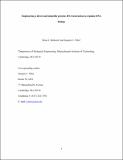Engineering a Direct and Inducible Protein-RNA Interaction To Regulate RNA Biology
Author(s)
Belmont, Brian Joshua; Niles, Jacquin
DownloadBelmont & Niles_ACS Chem Bio_2010.pdf (3.566Mb)
OPEN_ACCESS_POLICY
Open Access Policy
Creative Commons Attribution-Noncommercial-Share Alike
Terms of use
Metadata
Show full item recordAbstract
The importance and pervasiveness of naturally occurring regulation of RNA function in biology is increasingly being recognized. A common mechanism uses inducible protein−RNA interactions to shape diverse aspects of cellular RNA fate. Recapitulating this regulatory mode in cells using a novel set of protein−RNA interactions is appealing given the potential to subsequently modulate RNA biology in a manner decoupled from endogenous cellular physiology. Achieving this outcome, however, has previously proven challenging. Here, we describe a ligand-responsive protein−RNA interaction module, which can be used to target a specific RNA for subsequent regulation. Using the Systematic Evolution of Ligands by Exponential Enrichment (SELEX) method, RNA aptamers binding to the bacterial Tet Repressor protein (TetR) with low- to subnanomolar affinities were obtained. This interaction is reversibly controlled by tetracycline in a manner analogous to the interaction of TetR with its cognate DNA operator. Aptamer minimization and mutational analyses support a functional role for two conserved sequence motifs in TetR binding. As an initial illustration of using this system to achieve protein-based regulation of RNA function in living cells, insertion of a TetR aptamer into the 5′-UTR of a reporter mRNA confers post-transcriptionally regulated, ligand-inducible protein synthesis in E. coli. Altogether, these results define and validate an inducible protein−RNA interaction module that incorporates desirable aspects of a ubiquitous mechanism for regulating RNA function in Nature and can be used as a foundational interaction for functionally and reversibly controlling the multiple fates of RNA in cells.
Date issued
2010-06Department
Massachusetts Institute of Technology. Department of Biological EngineeringJournal
ACS Chemical Biology
Publisher
American Chemical Society
Citation
Belmont, Brian J., and Jacquin C. Niles. “Engineering a Direct and Inducible Protein−RNA Interaction To Regulate RNA Biology.” ACS Chemical Biology 5.9 (2010): 851-861.
Version: Author's final manuscript
ISSN
1554-8929
1554-8937